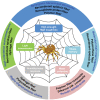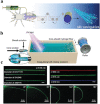Spider Silk-Inspired Artificial Fibers
- PMID: 34927397
- PMCID: PMC8844500
- DOI: 10.1002/advs.202103965
Spider Silk-Inspired Artificial Fibers
Abstract
Spider silk is a natural polymeric fiber with high tensile strength, toughness, and has distinct thermal, optical, and biocompatible properties. The mechanical properties of spider silk are ascribed to its hierarchical structure, including primary and secondary structures of the spidroins (spider silk proteins), the nanofibril, the "core-shell", and the "nano-fishnet" structures. In addition, spider silk also exhibits remarkable properties regarding humidity/water response, water collection, light transmission, thermal conductance, and shape-memory effect. This motivates researchers to prepare artificial functional fibers mimicking spider silk. In this review, the authors summarize the study of the structure and properties of natural spider silk, and the biomimetic preparation of artificial fibers from different types of molecules and polymers by taking some examples of artificial fibers exhibiting these interesting properties. In conclusion, biomimetic studies have yielded several noteworthy findings in artificial fibers with different functions, and this review aims to provide indications for biomimetic studies of functional fibers that approach and exceed the properties of natural spider silk.
Keywords: biomimetics; hydrogel fiber; recombinant spider silk; spider silk; strong and tough fibers.
© 2021 The Authors. Advanced Science published by Wiley-VCH GmbH.
Conflict of interest statement
The authors declare no conflict of interest.
Figures







References
-
- Huang X., Liu G., Wang X., Adv. Mater. 2012, 24, 1482. - PubMed
-
- Liu D., Yu L., He Y., Peng K., Liu J., Guan J., Dunstan D. J., Appl. Phys. Lett. 2017, 111, 013701.
Publication types
MeSH terms
Substances
Grants and funding
- 2019YFE0119600/National Key Research and Development Program of China
- 51973093/National Natural Science Foundation of China
- U1533122/National Natural Science Foundation of China
- 51773094/National Natural Science Foundation of China
- 63181206/"Frontiers Science Center for New Organic Matter", Nankai University
- National Special Support Plan for High level Talents people
- 18JCJQJC46600/Science Foundation for Distinguished Young Scholars of Tianjin
- Shanghai Synchrotron Radiation Facility
- XLYC1802042/Xingliao Talent Plan
- LX20200420001/Key Laboratory of Display Materials and Photoelectric Devices
- 63171219/Fundamental Research Funds for the Central Universities
LinkOut - more resources
Full Text Sources
